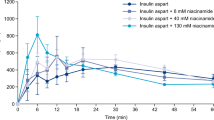Summary
The haemodynamic effects and plasma concentrations of glyceryl trinitrate (GTN) and its dinitrate metabolites were investigated in 8 healthy male volunteers during 5 days of application of a new transdermal delivery system (TDS) with time-dependent release characteristics, which were considered to prevent or to diminish development of nitrate tolerance.
On the first and fifth day of administration the following haemodynamic parameters were determined: digital pulse ratio of height of systolic peak to height of dicrotic wave (i.e.a/b-ratio), heart rate and systolic blood pressure under orthostatic conditions.
Peak plasma concentrations of GTN were 139 and 155 pg·ml−1 on the first and fifth day of treatment, and the corresponding trough concentrations (i.e. 24 h after administration) were 52.5 and 36.6 pg·ml−1, respectively.
Compared to placebo, the area under the effect curve of the a/b-ratio of the digital pulse was increased on the first (25.6%) and fifth day (13%). A significant increase of heart rate and a decrease of systolic blood pressure were seen only on the first day of treatment. The haemodynamic effects of sublingual GTN 0.8 mg were reduced by 69% (a/b-ratio) and 52% (standing heart rate) on the fifth day compared to the pretreatment values.
Thus, the phasic release of GTN from the new TDS can be demonstrated by the time course of the plasma concentrations of GTN and its metabolites. Nevertheless, following repeated administration the hemodynamic effects are blunted.
Similar content being viewed by others
References
Crean PA, Ribeiro P, Crean F, Davies GJ, Ratcliffe D, Maseri A (1984) Failure of transdermal nitroglycerin to improve chronic stable angina: A randomized, placebo-controlled, double-blind, double crossover trial. Am Heart J 108: 1494–1500
Parker JO, Fung HL (1984) Transdermal nitroglycerin in angina pectoris. Am J Cardiol 54: 471–476
Reiniger G, Kraus F, Dirschinger J, Blasini R, Rudolph W (1985) High-dose transdermal nitroglycerin treatment: Attenuated action within 24 hours? Herz 10: 157–162
Jordan RA, Seth L, Casebolt P, Hayes MJ, Wilen MM, Franciosa J (1986) Rapidly developing tolerance to transdermal nitroglycerin in congestive heart failure. Ann Intern Med 104: 295–298
Flaherty JT (1985) Hemodynamic attenuation and the nitrate-free interval: Alternative dosing strategies for transdermal nitroglycerin. Am J Cardiol 56: 321–371
Boertz A, Bonn R (1986) Nitrate therapy without loss of action by correct dosage. Z Kardiol 75 [Suppl 3]: 57–60
Cowan JC, Bourke JP, Reid DS, Julian DG (1987) Prevention of tolerance to nitroglycerin patches by overnight removal. Am J Cardiol 60: 271–275
Sharpe N, Coxon R, Webster M, Luke R (1987) Hemodynamic effects of intermittent transdermal nitroglycerin in chronic congestive heart failure. Am J Cardiol 59: 895–899
Imhof PR, Ott B, Frankhauser P, Chu LC, Hodler J (1980) Difference in nitroglycerin dose-response in the venous and arterial beds. Eur J Clin Pharmacol 18: 455–460
Wagner F, Siefert F, Trenk D, Jähnchen E (1990) Relationship between pharmacokinetics and hemodynamic tolerance to isosorbide-5-mononitrate. Eur J Clin Pharmacol 38 [Suppl 1]: S53-S59
Settlage JA, Gielsdorf W, Jaeger H (1983) Femtogram level quantitative determination of nitroglycerin and metabolites in human plasma by GC-MS negative ion chemical ionization, single ion monitoring. J High Resol Chromatogr Chromatogr Comm 6: 68–71
Wolff M, Cordes G, Luckow V (1985) In vitro and in vivo-release of nitroglycerin from a new transdermal therapeutic system. Pharm Res 1: 23–29
Noonan PK, Benet LZ (1987) Variable glyceryl dinitrate formation as a function of route of nitroglycerin administration. Clin Pharmacol Ther 42: 273–277
Morikawa Y (1967) Characteristic pulse wave caused by organic nitrates. Nature 25: 841–842
Müller M, Isenschmidt M, Bührer M, Bircher J (1984) Die automatische Fingerpulsplethysmographie als humanpharmakologisches Forschungsinstrument. Arzneim-Forsch/Drug Res 34: 702–706
Olivari MT, Carlyle PF, Levine B, Cohn JN (1983) Hemodynamic and hormonal response to transdermal nitroglycerin in normal subjects and in patients with congestive heart failure. J Am Coll Cardiol 2: 872–878
Author information
Authors and Affiliations
Rights and permissions
About this article
Cite this article
Wiegand, A., Bonn, R., Wagner, F. et al. Haemodynamic effects of glyceryl trinitrate following repeated application of a transdermal delivery system with a phasic release profile. Eur J Clin Pharmacol 41, 115–118 (1991). https://doi.org/10.1007/BF00265902
Received:
Accepted:
Issue Date:
DOI: https://doi.org/10.1007/BF00265902




